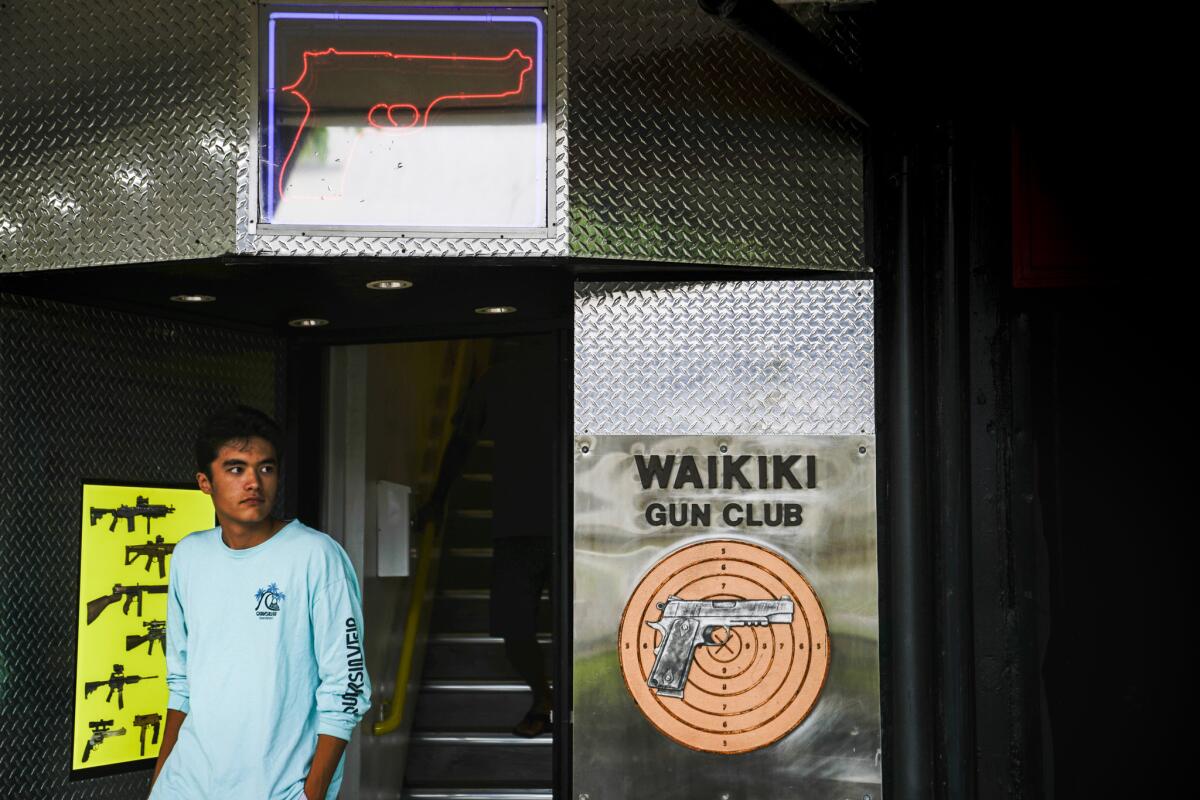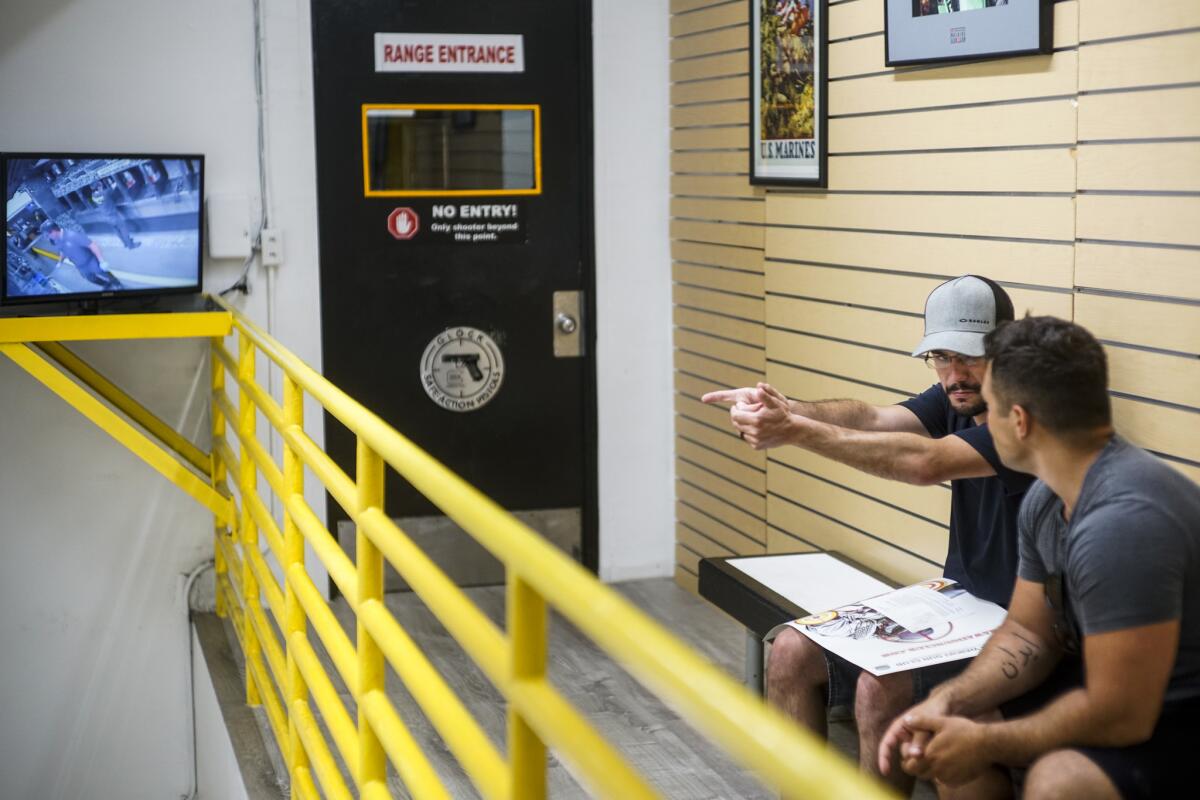For nations with strict gun laws, this little shooting range in Hawaii is a haven for tourists

- Share via
Reporting from Honolulu — There is an old bazooka resting on the white ventilation system just above Lynn Pang’s head.
“We don’t have ammunition for that,” she says cheerily.
But the Waikiki Gun Club seems to have most everything else. There are AR-15s, AK-47s and a Beowulf .50-caliber beast that comes equipped with a monopod beneath the barrel to support its heavy frame.
The place is tucked in a sliver of property on bustling Kalakaua Avenue in Waikiki. Sandwiched between Electric Paradise Tattoo and Laule’a (which sells flip-flops, handbags and suitcases), the club could be passed easily. Nearby is an upscale ramen restaurant, a Prada store and plate-glass windows highlighting expensive jewelry.
Its low-profile is one reason manager Eric Yang has people handing out fliers to the herds of tourists wandering the sidewalks — their arms loaded with name-brand shopping bags and clutching smartphones to take pictures of paradise.
Yang said most of his customers come from Australia, China and Japan — places with much stricter gun laws than the United States. He said his gun range is a chance for these visitors to shoot weapons they couldn’t even see, let alone touch, in their home countries.
For 13 hours a day, six days a week, and 12 hours on Sunday, the door is open. A sign reads, “Experience Live Firearms! Feel the Power!” Above, a neon outline of a gun glows red, promising a tantalizing, titillating moment of adrenaline fueled by Hollywood action heroes. Right by the front desk, a squinting John Wayne is pictured, bracketed by his famous line, “A man’s got to do what a man’s got to do.”

A group of eight Chinese visitors arrives on a Sunday afternoon. They speak no English, but Pang collects their payments, looks at their passports and has them sign the paperwork. Each of them is given a pen with a bright yellow plastic flower attached to the end. As they all sign, it looks like a row of flowers waving in a light breeze. Catchy pop music plays in the background.
Behind Pang are bright screens that display what resembles a menu from a fast-food restaurant.
There’s the A Course, which is a basic package of three handguns and 36 shots for $79. The C Course is the most popular, Pang said. It’s like a combo meal for gun enthusiasts: three handguns, three rifles and 55 rounds for $149. The super-sized option features more exotic fare, including a 9-millimeter Uzi.
After shooting packages and targets are chosen, the customers walk past printed images featuring the U.S. Marine Corps, a Sept. 11 memorial poster and another showing shooting champion Todd Jarrett.
A black door is buzzed and they walk through and wait in a small holding area before another door opens to the shooting range.

Only those who pay to shoot are allowed in the indoor range. But observers can watch the action on a black-and-white monitor in the narrow waiting area lined with two benches.
One of the older women holds a rifle uncomfortably while an instructor helps her. In the lane next to her, a man levels a handgun and squeezes off a few rounds. In the waiting area, the sounds of the shots can be heard — deep, low thuds that sound like a hammer hitting a wall.
Pang stands behind the counter doing paperwork and doesn’t look up while the guns fire from the other side of the wall. She’s worked here about a year and said she’d never fired a gun until taking the job at the front desk. Pang said that it’s a way to make some extra money and that she’s since learned to fire a pistol. Shotguns scare her, though. “Too big,” she says with a laugh.
When the Chinese tourists are done — less than 30 minutes — the older woman in flared pants and flip-flops holds her target in front of her and smiles while her picture is taken with a smartphone. The others compare their zombie-themed targets. Several of the zombies appeared to have survived the onslaught.
Gun restrictions in China are among the toughest in the world, and for most citizens, possession is a criminal offense that can lead to jail time. Pang said most of the Chinese and Japanese customers who come to the Waikiki Gun Club have never fired a gun. She said visitors from Japan and China account for more than 70% of their customers.


Australians tend to account for the rest of the visitors.
Marcus Axisa, 28, showed up to shoot guns that are impossible to fire in Sydney. According to Philip Alpers, adjunct associate professor at the University of Sydney’s School of Public Health, many of the guns at the Waikiki Gun Club — such as the AR-15 — are rarely used in Australia.
“Under the country’s most restrictive ‘Category D’ firearm license, a very small number of professional shooters of vertebrate pests are permitted to possess semi-auto rifles such as the AR-15,” Alpers said in an email to The Times. “These are the real Croc Dundees.”
The AR-15 is the one Axisa, a gun owner, liked best and one he couldn’t get his hands on in Sydney. He shot six guns at the Waikiki range and proved to be most accurate with the gun he had fired the least, the AR-15.
“It felt good,” he said. “Easy to handle.”
Yang said the range has been around since 1988 and has a second location a few miles away. They work with touring companies in Japan and China to bring in visitors, offering discounts through prepaid vouchers that are redeemed at the counter.
Exotic guns are a draw, but Dave Kopel, a prolific author on firearms laws and a Cato Institute associate policy analyst, said almost all the guns at the range would be considered exotic to most of the customers — even a 9-millimeter Glock handgun.
“For the Japanese visitor, it’s like doing something you’ve never done before at all,” Kopel said. “For the Australian, it’s like doing something you might be familiar with, but with different tools you haven’t used before.”
david.montero@latimes.com | Twitter: @davemontero
More to Read
Sign up for Essential California
The most important California stories and recommendations in your inbox every morning.
You may occasionally receive promotional content from the Los Angeles Times.











